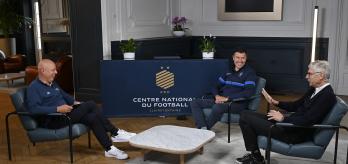Part 1: From lecture halls to the tactics board
00:08
Jonas's route into coaching
When the time came to choose between pursuing a career in the professional ranks of the game or embarking on university studies, Urias opted for the latter and went on to obtain a bachelor’s degree in sport from the University of São Paulo. The passionate tactician was inspired to coach in women’s football after witnessing the quality on show during sessions at the country’s Olympic Training Centre back in 2010, when the female game was very much in its infancy in Brazil. He subsequently went on to secure his coaching badges with the Brazilian Football Association (CBF), before further honing his craft by undertaking courses run by CONMEBOL and taking part in women’s football-specific training offered by FIFA.
02:40
Women's football in Brazil
Jonas was instantly captivated by the passion he encountered in the female game, noting that the players’ level of commitment and ability to overcome a hostile environment is what makes women’s football so special. He refers specifically to the pioneers who fought against the odds to pave the way for the future generations.
04:33
Current role
As a part of his role as head coach of the Brazil U-20 women’s team, Urias is involved in identifying the country’s hottest up-and-coming talents, while also playing a key role in preparing players to make the step-up to the senior national side.
Part 2: a player-centred approach
00:08
The role of a coach
Urias’s philosophy is based on the idea that coaches are facilitators of knowledge rather than being masters of all knowledge. He believes that coaching is all about helping players to fulfil their potential to become masters of knowledge that can be used both on and off the pitch.
01:58
On the pitch
The CBF coach explains that training sessions not only represent a tool to develop players’ knowledge and understanding but also to foster autonomy. His training methodology involves exercises that begin off the pitch and feature various strategies that enable players to discover individual and collective solutions to situations
4:04
Good atmosphere is key
Urias seeks to create an environment in which his players feel comfortable enough to express their ideas, which serves to promote their on-field creativity. He comments that it is vital for a coach to provide an atmosphere that is conducive to learning, in which players feel both challenged and engaged.
Part 3: connecting with players
00:08
Tools or answers?
Given that football places players in situations of vulnerability, they often seek security and answers from coaches, who must ensure that they are in a position to offer assurance. Urias states that simply giving the players the answer is not always the best option, with his preferred method being to provide them with the tools – at the right time – to find the answer.
01:55
Empowering players
Once players have become familiar with this learning method, they feel empowered to solve problems and develop the skill set to do so on their own during the course of a match. Working alongside the coaches to develop a game plan, rather than being told what to do, empowers the players and boosts their confidence.
04:26
Every group is unique
Coaches need to recognise that each group that they work with requires a different approach. In order to fully engage with players, coaches are tasked with constantly fine-tuning their methods. Urias stresses that it is crucial that a coach has a strong understanding of their players. As an example, he says that it is vital to incorporate fun elements when working with younger players, who simply want to play, while consideration must be given to the fact that adults are motivated by other factors.
When they, as players, are involved in developing the game plan together with the coaches, they feel unshackled.



































